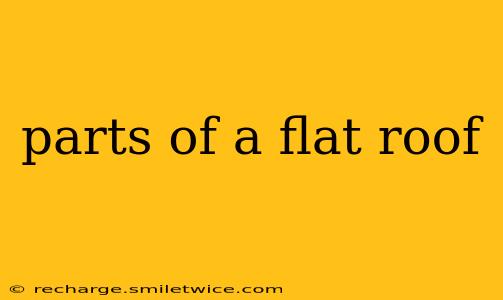Flat roofs, while seemingly simple in design, are actually comprised of several crucial components working in harmony to provide a weathertight and durable covering for your building. Understanding these parts is essential for both homeowners and professionals involved in construction, maintenance, and repair. This guide will break down the key elements of a flat roof system, helping you navigate the intricacies of this often-overlooked architectural feature.
What are the Main Components of a Flat Roof?
A typical flat roof system isn't truly flat; it has a slight slope (typically 1/4 inch per foot) to facilitate water drainage. The key components include:
-
Deck: This is the structural base of the roof, often made of wood, concrete, or steel. Its condition is paramount to the overall roof's health. A damaged deck can lead to leaks and structural problems.
-
Insulation: Placed on top of the deck, insulation minimizes heat transfer, reducing energy costs and improving indoor comfort. Common insulation materials include rigid foam boards, fiberglass, and spray foam. The type and thickness of insulation greatly affect the roof's energy efficiency.
-
Vapor Barrier: This layer prevents moisture from inside the building from penetrating the insulation and roof assembly. A compromised vapor barrier can lead to significant moisture problems, causing mold growth and structural damage.
-
Cover Board: This is a protective layer typically made of plywood or OSB (oriented strand board) placed over the insulation. It provides a smooth, even surface for the roofing membrane and helps to distribute weight evenly.
-
Roofing Membrane: This is the waterproof top layer of the flat roof, responsible for shedding water and protecting the underlying components. Common materials include:
- EPDM (Ethylene Propylene Diene Monomer): A rubber membrane known for its durability and longevity.
- TPO (Thermoplastic Polyolefin): A single-ply membrane that’s lightweight, reflective, and relatively easy to install.
- PVC (Polyvinyl Chloride): A durable and versatile membrane, often reinforced with fiberglass.
- Modified Bitumen: A more traditional asphalt-based roofing system known for its affordability.
-
Flashing: These metal pieces are crucial for sealing around penetrations like pipes, vents, and skylights. Proper flashing prevents water from entering the roof system at these vulnerable points.
-
Gravel/Ballasted Systems (for some membranes): In some cases, a layer of gravel or ballast is added on top of the membrane to provide additional protection and weight to hold the membrane down.
What is the difference between a built-up roof (BUR) and a single-ply roof?
This is a common question, and the difference lies primarily in the roofing membrane:
-
Built-up Roof (BUR): This is a multi-layered system using multiple layers of asphalt and felt. BUR systems are generally more durable but more complex and costly to install and repair compared to single-ply systems.
-
Single-Ply Roof: As the name suggests, this system uses a single layer of membrane material. Single-ply membranes are typically easier to install and repair, making them a cost-effective option for many.
How long does a flat roof last?
The lifespan of a flat roof depends heavily on several factors, including:
- Materials used: Higher-quality materials generally last longer.
- Climate: Harsh weather conditions can significantly shorten the lifespan.
- Proper installation: Professional installation is critical for longevity.
- Regular maintenance: Regular inspections and prompt repairs extend the roof's life.
Generally, a well-maintained flat roof can last anywhere from 15 to 30 years, but this is just an estimate.
What are the common problems with flat roofs?
Several issues can plague flat roofs, including:
- Leaks: These can stem from damaged membranes, improper flashing, or a compromised deck.
- Ponding water: Poor drainage can lead to water accumulating on the roof, causing damage.
- Membrane punctures: Debris and impacts can puncture the membrane, leading to leaks.
- Poor insulation: Inadequate insulation can lead to high energy bills and moisture problems.
What are the benefits of a flat roof?
Despite their potential challenges, flat roofs offer several advantages:
- Cost-effective: They are often less expensive to install than sloped roofs.
- Easy access: The flat surface provides easy access for maintenance and repairs.
- Additional usable space: The roof can be utilized for recreational purposes or rooftop gardens.
By understanding the individual parts and potential issues associated with flat roofs, you can make informed decisions about construction, maintenance, and repairs, ensuring your roof provides years of reliable service. Remember to consult with qualified roofing professionals for any significant work or concerns.
